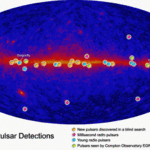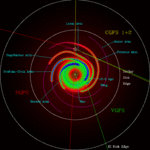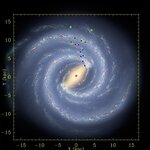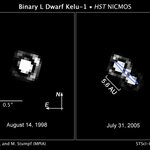Space

Researchers have discovered that the mysterious overweight stars known as blue stragglers are the result of 'stellar cannibalism', where plasma is gradually pulled from one star to another to form a massive, unusually hot star that appears younger than it is. The process takes place in binary stars star systems consisting of two stars orbiting around their common centre of mass. This helps to resolve a long standing mystery in stellar evolution.
Blue stragglers are found throughout the Universe in globular clusters - collections of about 100, 000 stars, tightly bound by gravity. According…

XMM-Newton has caught the fading glow of a tiny celestial object, revealing its rotation rate for the first time. The new information confirms this particular object as one of an extremely rare class of stellar zombie – each one the dead heart of a star that refuses to die. There are just five so-called Soft Gamma-ray Repeaters (SGRs) known, four in the Milky Way and one in our satellite galaxy, the Large Magellanic Cloud. Each is between 10 and 30 km across, yet contains about twice the mass of the Sun. Each one is the collapsed core of a large star that has exploded, collectively…

Many objects in the universe emit radio waves. In 1931, American physicist Karl Jansky first detected radio static from our own Milky Way galaxy. Similar emission from other galaxies creates a background hiss of radio noise.
Now a team led by Alan Kogut of NASA's Goddard Space Flight Center in Greenbelt, Md., today announced the discovery of cosmic radio noise that booms six times louder than expected.
The finding comes from a balloon-borne instrument named ARCADE, which stands for the Absolute Radiometer for Cosmology, Astrophysics, and Diffuse Emission. In July 2006, the instrument…

Astronomers say they may have solved one of those classic chicken-and-egg problems, namely, which came first in the early Universe, galaxies or the supermassive black holes seen at their cores.
Chris Carilli, of the National Radio Astronomy Observatory (NRAO), outlined the conclusions from recent research done by an international team studying conditions in the first billion years of the Universe's history in a lecture presented to the American Astronomical Society's meeting in Long Beach, California.
Earlier studies of galaxies and their central black holes in the nearby Universe revealed an…

NASA's Fermi Gamma-ray Space Telescope has discovered 12 new gamma-ray-only pulsars and has detected gamma-ray pulses from 18 others. The finds are transforming our understanding of how these stellar cinders work.
"We know of 1,800 pulsars, but until Fermi we saw only little wisps of energy from all but a handful of them," says Roger Romani of Stanford University, Calif. "Now, for dozens of pulsars, we're seeing the actual power of these machines."
A pulsar is a rapidly spinning and highly magnetized neutron star, the crushed core left behind when a massive sun explodes. Most were found…

Two new efforts have taken a famous supernova remnant from the static to the dynamic. A new movie of data from NASA's Chandra X-ray Observatory shows changes in time never seen before in this type of object. A separate team will also release a dramatic three-dimensional visualization of the same remnant.
Nearly ten years ago, Chandra's "First Light" image of Cassiopeia A (Cas A) revealed previously unseen structures and detail. Now, after eight years of observation, scientists have been able to construct a movie that tracks the remnant's expansion and changes over time.
"With Chandra, we have…

We may not be using it for navigation any time soon, but a new map of our own Milky Way galaxy provides other answers about the structure of our galaxy, and resolves conflicting information gathered from previous surveys.
Many previous mappings of the Milky Way have focused on either the inner galaxy or the outer galaxy, and as a result, different surveys have found different numbers of spiral arms - two in the inner galaxy and four in the outer. Now, Iowa State University has completed the first map of the entire system of galactic spiral arms, which shows two arms at the center branching…

Astronomers have turned to an unexpected place to study the evolution of planets -- dead stars.
Observations made with NASA's Spitzer Space Telescope reveal six dead "white dwarf" stars littered with the remains of shredded asteroids. This might sound pretty bleak, but it turns out the chewed-up asteroids are teaching astronomers about the building materials of planets around other stars.
So far, the results suggest that the same materials that make up Earth and our solar system's other rocky bodies could be common in the universe. If the materials are common, then rocky planets…

Let's face it, with all that talk about life on other planets and dark matter, we lose sight of the big picture. To start 2009 off right, the Milky Way, our galaxy, wants you to know she is not out of coolness yet. To wit, new measurements of the Milky Way say our home Galaxy is rotating about 100,000 miles per hour faster than previously thought.
That increase in speed, said Mark Reid, of the Harvard-Smithsonian Center for Astrophysics, also increases the Milky Way's mass by 50 percent, bringing it even with the Andromeda Galaxy. "No longer will we think of the Milky Way as the…

Brown dwarfs, objects that are less massive than stars but larger than planets, just got more elusive, based on a study of 233 nearby multiple-star systems by NASA's Hubble Space Telescope. Hubble found only two brown dwarfs as companions to normal stars. This means the so-called "brown dwarf desert" (the absence of brown dwarfs around solar-type stars) extends to the smallest stars in the universe.
The 233 stars surveyed are part of the RECONS (Research Consortium on Nearby Stars) survey meant to understand the nature of the sun's nearest stellar neighbors, both individually and as a…